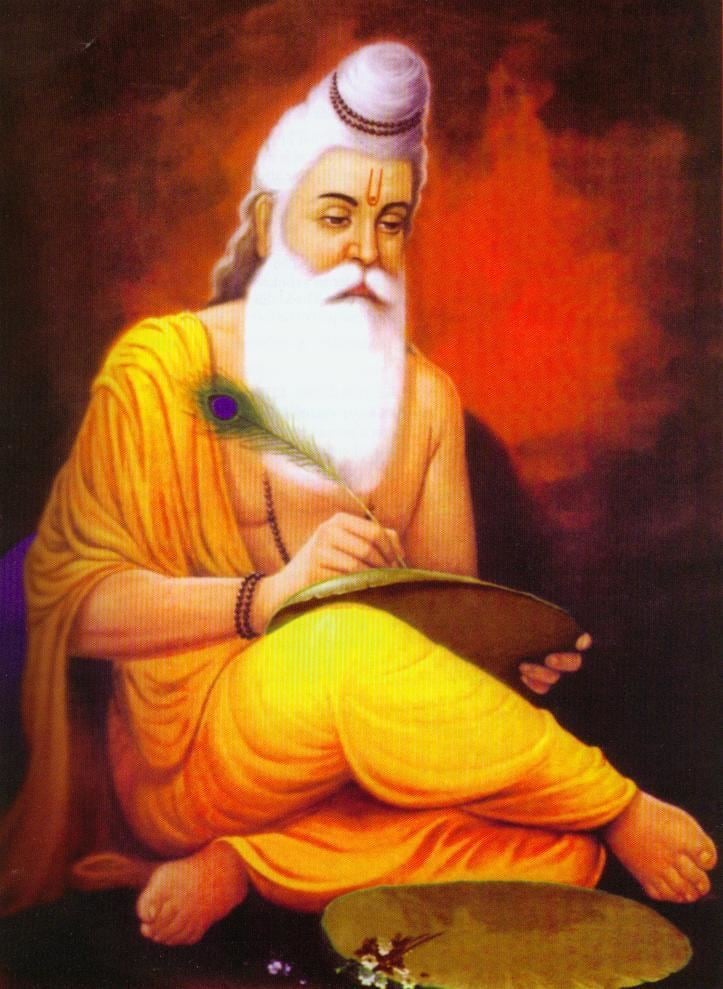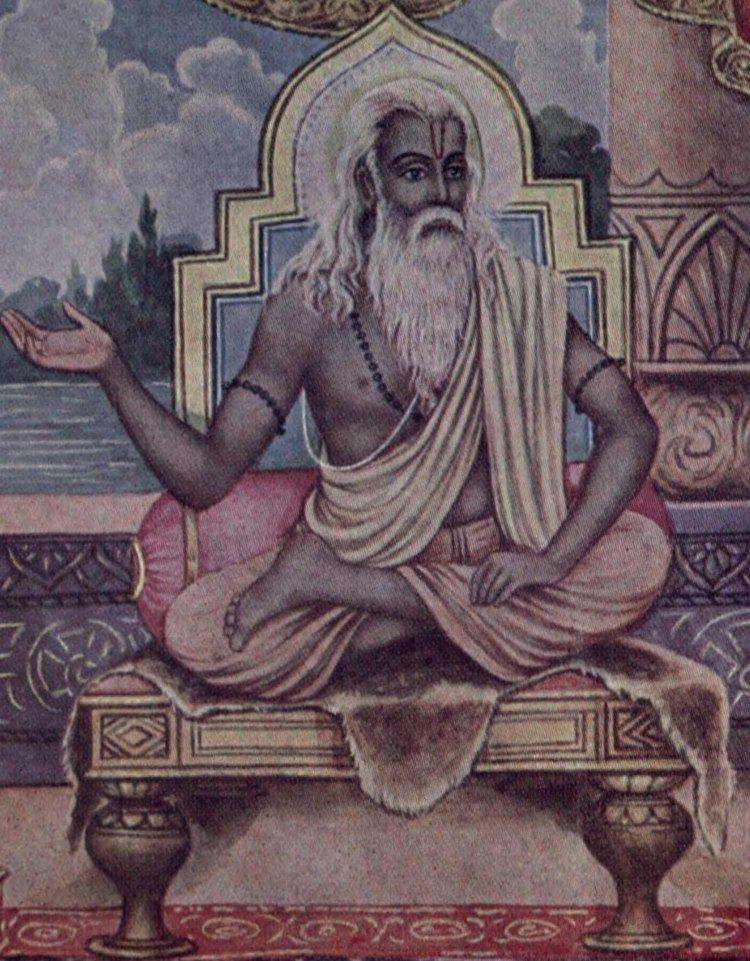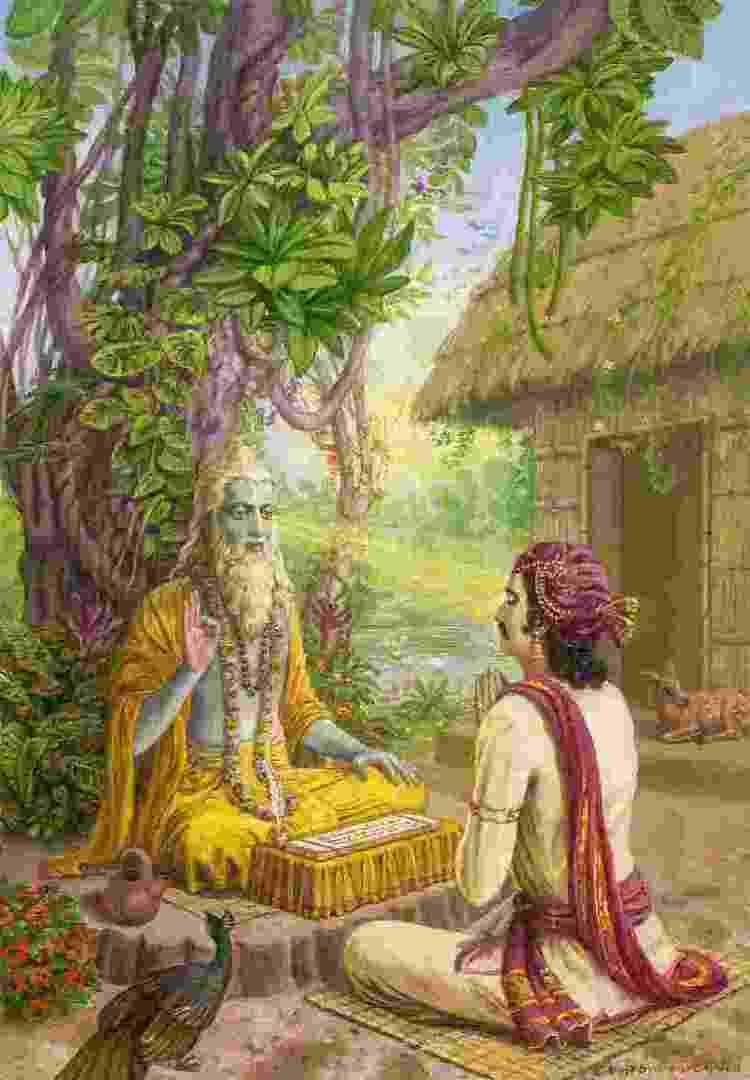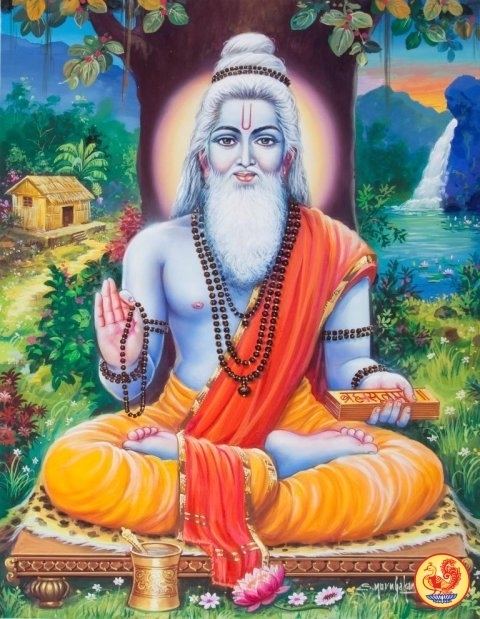Name Krishna Dwaipayana Role Author Parents Parashara, Satyavati | Children Shuka, Vidura, Pandu Ex-spouse Pinjala | |
 | ||
Titles/honours Festival of Guru Purnima, is dedicated to him, and also known as Vyasa Purnima as it is the day, which is believed to be his birthday Movies The Mahabharata, Mahabharat Books Mahabharata, Bhagavata Purana, Vishnu Purana, Bhagavad Gita, The Mahabharata of Krishn Similar People Satyavati, Parashara, Valmiki, Krishna Dharma, Madeleine Biardeau | ||
Why we call veda vyasa author of the mahabharata four vedas
Vyasa (Sanskrit: व्यास, literally "Compiler") is a central and revered figure in most Hindu traditions. He is also sometimes called Veda Vyāsa (वेदव्यास, veda-vyāsa, "the one who classified the Vedas"), or Krishna Dvaipāyana (referring to his complexion and birthplace). He is generally considered the author of the Mahabharata, as well as a character in it, and the scribe of both the Vedas and Puranas. Vyasa is also considered to be one of the seven Chiranjivins (long lived, or immortals), who are still in existence according to Hindu belief. According to the Vishnu Purana, "Veda Vyasa" is a title applied to the compilers of the Vedas who are avatars of Vishnu; 28 people with this title have appeared so far.
Contents
- Why we call veda vyasa author of the mahabharata four vedas
- Vyasa mahabharata story ganesh pens the mahabharata ganesh chaturthi
- In the Mahabharata
- Early life
- Veda Vyasa
- Chronicler of the Mahabharata
- Vyasas Jaya
- Ugrasrava Sautis Mahbhrata
- Reference to writing
- Other texts attributed
- In Sikhism
- References

The festival of Guru Purnima is dedicated to him. It is also known as Vyasa Purnima, for it is the day believed to be both his birthday and the day he divided the Vedas. He was known as badarayana

Vyasa mahabharata story ganesh pens the mahabharata ganesh chaturthi
In the Mahabharata

Vyasa appears for the first time as the compiler of, and an important character in, the Mahabharata. It is said that he was the expansion of the god Vishnu who came in Dwaparayuga to make all the Vedic knowledge available in written form which was available in spoken form at that time. He was the son of Satyavati, daughter of the fisherman Dusharaj, and the wandering sage Parashara (who is credited with being the author of the first Purana, Vishnu Purana). There are two different views regarding his birthplace. One of the views suggests that he was born in the Tanahun district in western Nepal, in Vyas municipality of Gandaki zone of Tanahun district, and his name, Vedh Vyas, names his birthplace. Another view suggests that he was born on an island in the Yamuna River near Kalpi, Uttar Pradesh, India. Vyasa was dark-complexioned and hence may be called by the name Krishna, and also the name Dwaipayana, meaning 'island-born'.

Dhritarashtra born of Ambika, and Pandu, born of Ambalika and Vidura born to a maid, were born from Vyasa's powers (Siddhis).
Vyasa is believed to have lived on the banks of Ganga in modern-day Uttarakhand. The place was also the abode of the sage Vashishta along with the Pandavas, the five brothers of the Mahabharata.
According to the Mahabharatha, Maharishi Vyas and his disciples and the sage Viswamitra decided to settle down in a cool and serene atmosphere after the Kurukshetra War. In the quest for a peaceful abode, he came to the Dandaka forest and, pleased with serenity of the region, selected this place. Since Maharishi Vyasa spent considerable time in prayers, the place was then called "Vasara", which became turned into Basar (in Telangana) due to the influence of the Marathi language in this region.
Early life
In his previous life, Vyasa was the Sage Apantaratamas, who was born when Lord Vishnu uttered the syllable "Bhu". He was a devotee of Lord Vishnu. Since birth, he already possessed the knowledge of the Vedas, the Dharmashastras and the Upanishads. At Vishnu's behest, he was reborn as Vyasa.
Sage Parashara was the father of Vyasa and the grandson of Sage Vashistha. Prior to Vyasa's birth, Parashara had performed a severe penance to Lord Shiva. Shiva granted a boon that Parashara's son would be a Brahmarshi equal to Vashistha and would be famous for his knowledge.
Parashara begot Vyasa on Satyavati. She conceived and immediately gave birth to Vyasa. Vyasa turned into an adult and left, promising his mother that he would come to her when needed.
Vyasa acquired his knowledge from the four Kumaras, Narada and Lord Brahma himself.
Veda Vyasa
Hindus traditionally hold that Vyasa categorised the primordial single Veda into three canonical collections, and that the fourth one, known as Atharvaveda, was recognized as Veda only very much later. Hence he was called Veda Vyasa, or "Splitter of the Vedas," the splitting being a feat that allowed people to understand the divine knowledge of the Veda. The word vyasa means split, differentiate, or describe.
The Vishnu Purana has a theory about Vyasa. The Hindu view of the universe is that of a cyclic phenomenon that comes into existence and dissolves repeatedly. Each cycle is presided over by a number of Manus, one for each Manvantara, that has four ages, Yugas of declining virtues. The Dvapara Yuga is the third Yuga. The Vishnu Purana (Book 3, Ch 3) says:
In every third world age (Dvapara), Vishnu, in the person of Vyasa, in order to promote the good of mankind, divides the Veda, which is properly but one, into many portions. Observing the limited perseverance, energy, and application of mortals, he makes the Veda fourfold, to adapt it to their capacities; and the bodily form which he assumes, in order to effect that classification, is known by the name of Veda-vyasa. Of the different Vyasas in the present Manvantara and the branches which they have taught, you shall have an account. Twenty-eight times have the Vedas been arranged by the great Rishis in the Vaivasvata Manvantara... and consequently eight and twenty Vyasas have passed away; by whom, in the respective periods, the Veda has been divided into four. The first... distribution was made by Svayambhu (Brahma) himself; in the second, the arranger of the Veda (Vyasa) was Prajapati... (and so on up to twenty-eight).
As per Vishnu Purana, Guru Drona's son rishi Aswatthama will become the next sage Vyasa (title), who in turn divide the Veda in 29th Mahayuga of 7th Manvantara.
Chronicler of the Mahabharata
Vyasa is traditionally known as the chronicler of this epic, and also features as an important character in it. According to the legend, the sage Vyasa was the son of Satyavati and Parashara. During her youth Satyavati was a fisherwoman who used to drive a boat. One day the sage Parashara was in a hurry to attend a yaga. Satyavati helped him cross the river borders. On this account, the sage offered her a mantra which would result in begetting a son who would be a sage with wisdom and all good qualities. Satyavati immediately recited the mantra, and thus Vyasa was born. She kept this incident a secret, not telling even King Shantanu. After many years, Shantanu and Satyavati had two sons, named Chitrangada and Vichitraviriya. Chitrangada was killed by Gandharvas in a battle, while Vichitraveriya was weak and ill all the time. Satyavati then asked Bhisma to fetch queens for Vichitravirya. Bhishma attend the swayamvara conducted by the king of Kashi (present-day Varanasi), and defeated all the kings. He forceibly abducted the three princesses Amba, Ambika and Ambalika, the last of whom was to create trouble for Bhishma. Amba, already in love with the prince of Shalva, she to marry Vichitraviriya, and later she vowed to kill Bhishma. During the wedding ceremony, Vichitraviriya collapsed and died, and Satyavati didn't know how to save the clan from perishing. She asked Bhishma to marry both the queens but he refused, as he had already promised her and her father not to marry anyone, and so could not father an heir to the kingdom. Later she revealed to Bhishma the secret of her past life and asked him to bring Vyasa to Hastinapur. Sage Vyasa asked his mother to send Ambika to the waiting room. By his tapsya, Vyasa granted a child to Ambika. On being afraid Ambika was panicked. Later Vysa told her that due to her mistake in tapsya, her child would be blind; this child was Dhirdharashtra. Later Vyasa asked Ambalika to attend the waiting room. He granted a child; this child was Pāndu. Then he told Satyavati to send one of the princesses again so that a healthy child could be born. This time Ambika and Ambālika sent a maid in their place. The maid was quite calm and composed, and she had a healthy child later named as Vidura. While these are his sons, another son Shuka, born of his wife Pinjalā (Vatikā), daughter of the sage Jābāli, is considered his true spiritual heir. He makes occasional appearances in the story as a spiritual guide to the young princes.
In the first book of the Mahābhārata, Vyasa asks Ganesha to aid him in writing the text, but Ganesha imposed a condition that he would do so only if Vyasa narrated the story without pause. Vyasa replied with a counter-condition, that Ganesha must understand the verse before he transcribed it. Thus Vyasa narrated the entire Mahābhārata and all the Upanishads and the 18 Puranas, while Lord Ganesha wrote.
Vyasa is supposed to have meditated and authored the epic by the foothills of the river Beas (Vipasa) in the Punjab region.
Vyasa's Jaya
Vyasa's Jaya (literally, "victory"), the core of the Mahābhārata, is structured in the form of a dialogue between Dhritarashtra (the Kuru king and the father of the Kauravas, who opposed the Pāndavas in the Kurukshetra War) and Sanjaya, his adviser and charioteer. Sanjaya narrates the particulars of the Kurukshetra War, fought in eighteen days, chronologically. Dhritarāshtra at times asks questions and expresses doubts, sometimes lamenting, knowing of the destruction caused by the war to his sons, friends and kinsmen.
Sanjaya, in the beginning, gives a description of the various continents of the Earth and numerous planets, and focuses on the Indian subcontinent. Large and elaborate lists are given, describing hundreds of kingdoms, tribes, provinces, cities, towns, villages, rivers, mountains, forests, etc. of the (ancient) Indian subcontinent (Bhārata Varsha). Additionally, he gives descriptions of the military formations adopted by each side on each day, the death of individual heroes and the details of the war-races. Eighteen chapters of Vyasa's Jaya constitute the Bhagavad Gita, a sacred text in Hinduism. Thus, the Jaya deals with diverse subjects, such as geography, history, warfare, religion and morality.
Ugrasrava Sauti's Mahābhārata
The final version of Vyasa's work is the Mahābhārata. It is structured as a narration by Ugrasrava Sauti, a professional story teller, to an assembly of rishis who, in the forest of Naimisha, had just attended the 12 year sacrifice known as Saunaka, also known as "Kulapati".
Reference to writing
Within the Mahābhārata, there is a tradition in which Vyasa wishes to write down or inscribe his work:
The Grandsire Brahma (creator of the universe) comes and tells Vyasa to get the help of Ganapati for his task. Ganapati writes down the stanzas recited by Vyasa from memory and thus the Mahābhārata is inscribed or written.There is some evidence however that writing may have been known earlier based on archeological findings of styli in the Painted Grey Ware culture, dated between 5000 B.C. and 3000 B.C. and archeological evidence of the Brahmi script being used from at least 300 B.C.
Other texts attributed
Vyasa is also credited with the writing of the eighteen major Purāṇas. His son Shuka is the narrator of the major Purāṇa Bhagavat-Purāṇa.
The Yoga Bhashya, a commentary on the Yoga Sutras of Patanjali, is attributed to Vyasa.
The Brahma Sutra is attributed to Badarayana — which makes him the proponent of the crest-jewel school of Hindu philosophy, i.e., Vedanta. Vaishnavas conflate Vyasa with Badarayana because the island on which Vyasa was born is said to have been covered with badara (Indian jujube/Ber/Ziziphus mauritiana) trees. Some modern historians, though, suggest that these were two different personalities.
There may have been more than one Vyasa, or the name Vyasa may have been used at times to give credibility to a number of ancient texts. Much ancient Indian literature was a result of long oral tradition with wide cultural significance rather than the result of a single author. However, Vyasa is credited with documenting, compiling, categorising or writing commentaries on much of this literature.
In Sikhism
In Brahm Avtar, one of the compositions in Dasam Granth, the Second Scripture of Sikhs, Guru Gobind Singh mentions Rishi Vyas as an avatar of Brahma. He is considered the fifth incarnation of Brahma. Guru Gobind Singh wrote brief account of Rishi Vyas's compositions about great kings— Manu, Prithu, Bharath, Jujat, Ben, Mandata, Dilip, Raghu Raj and Aj— and attributed to him the store of Vedic learning.
